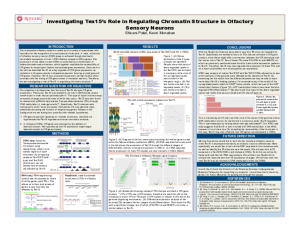Patel, Shivani: Investigating Tex15’s Role in Regulating Chromatin Structure in Olfactory Sensory Neurons
Title: Investigating Tex15’s Role in Regulating Chromatin Structure in Olfactory Sensory Neurons
Name: Shivani Patel
Major: Cell Biology and Neuroscience
School affiliation: School of Arts and Sciences
Programs: Division of Life Sciences Summer Undergraduate Research Fellowship (DLS-SURF)
Other contributors: Kevin Monahan
Abstract: The mammalian olfactory system is made of many specialized cells. The olfactory sensory neurons (OSNs) that make up this system are each responsible for recognizing specific odorants. In mice, a diversity of olfactory neuron types is achieved through the stochastic, monoallelic expression of over 1,200 olfactory receptor (ORs) genes. This monoallelic expression is controlled by heterochromatin and enhancers, which together modulate the accessibility of OR genes to transcription factors that activate gene expression. Early work in the lab has identified Tex15 as a regulator of OR gene expression, as mutations in this gene results in skewed expression favoring a small group of OR genes. However, Tex15 has a transient expression which coincides with the timing of OR gene choice in immature neurons. Previously, Tex15 was studied for its role in DNA double-strand break repair in male mice. This type of repair involves major chromatin change. Another recent study, found that Tex15 also helps silence Transposable elements (TEs) through DNA methylation in male germ cells. Based on this background, we hypothesize that Tex15 regulates enhancer chromatin structure. Also, since OR genes are silenced by the addition of heterochromatin in immature cells, we hypothesize that TE expression might target heterochromatin to OR gene clusters. In this study we used ATAC-seq data to find the differing peaks of open chromatin in Tex15 wild type and Tex15 knock out mature OSNs. This allowed us to find the motifs present in the up regulated and down regulated peaks. Furthermore, we found that many TE families are also transiently expressed during OSN differentiation. We then identified the TEs that were both enriched in OR clusters and have a similar expression pattern as Tex15. These results help provide insight on Tex15’s role in regulating chromatin structure, and how it may influence OR gene expression in OSNs.
